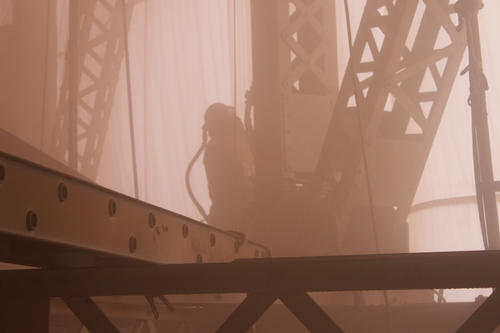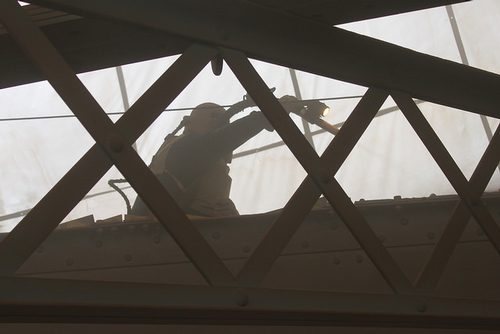WEDNESDAY, MARCH 7, 2018
The Occupational Safety and Health Administration announced late last week that it will begin enforcement of much of its new beryllium standard on May 11 in all industries, including construction and shipyard, but will not enforce ancillary provisions (such as engineering controls and medical surveillance) in construction and shipyard operations until further notice.
The beryllium rule was promulgated in January 2017 and met with resistance from some manufacturers of abrasive blasting media, which in some cases could be affected by the rule. Some abrasives contain trace amounts of beryllium that, in the context of blasting operations, could exceed the new action level of 0.1 micrograms of beryllium per cubic meter of air. The rule sets a new permissible exposure limit (PEL) of 0.2 micrograms per cubic meter, and a new short-term exposure limit (STEL) of 2.0 micrograms per cubic meter.

 |
| Images: Technology Publishing Co. |
|
OSHA's new beryllium rule, which could affect some abrasive blasting operations, will begin enforcement in May, though ancillary provisions including medical surveillance will not be enforced until further notice. |
The PEL and STEL will be enforced in the construction and shipyard industries beginning in May, but other provisions of the rule will not, as the agency continues to reconsider aspects of the rule. All aspects of the rule in general industry will be enforced, except certain provisions requiring change rooms and showers and some engineering controls, which will go into effect over the next two years.
The rule had been set to begin enforcement March 12, but the ongoing review announced last June spurred the two-month delay. The construction and shipyard rules are subject to additional rulemaking, and the general-industry rule has been the topic of “extensive settlement talks” with several parties, according to OSHA.
Rule Background
The new beryllium rule was published after years in development, authored primarily by OSHA, the United Steelworkers union and Materion Brush, the country’s largest supplier of beryllium. In general industry, beryllium is used as an aerospace material, in nuclear reactors and in some medical applications, as well as for other specialized uses.
Beryllium is a component of coal, certain rock materials, volcanic dust and soil that is used in several industrial applications. Breathing air containing beryllium can deposit beryllium particles in the lungs, presenting immune-system and respiratory risks. Beryllium is a known human carcinogen and can cause chronic lung disease.
An organization representing some suppliers of blasting abrasives, the Abrasive Blasting Manufacturers Alliance, argued during the original rulemaking process, and again after the publication of the rule, that there have historically been no cases of chronic beryllium disease known to have resulted from exposure via abrasive blasting.
OSHA’s supporting documents also repeatedly specify two particular types of abrasive media, coal slag and copper slag, as putting blasting workers at risk for beryllium exposure. The new rulemaking cites a number of studies performed for the National Institute for Occupational Safety and Health and for academic journals that look specifically at beryllium in mineral slag abrasives.
In reaction to OSHA's planned enforcement of the new beryllium PEL and STEL, the ABMA told PaintSquare Daily News it is not concerned, noting in a statement: “We do not expect any of our members or our customers to be adversely impacted by the new PEL and STEL because existing OSHA rules already ensure that workers are not exposed to beryllium at these new mandated levels. This new rule will apply to all blasting jobs no matter what abrasive is being used, slag, glass and garnet equally, but workers are already protected and there should be no disruption based on OSHA’s decision.”
New Study Released
In January, the ABMA released the results of a lab study that it says shows that crushed-glass abrasives—often presented as a beryllium-safe alternative to slag abrasives—contain trace amounts of beryllium and therefore could also exceed the PEL in some blasting situations. The study, conducted by consulting firm Exponent and funded by the ABMA, shows beryllium content between 0.27 and 0.76 parts per million in crushed-glass abrasives from three manufacturers.
The study did not include other abrasives; by comparison, many coal slag abrasives list beryllium at a concentration between 2 and 10 parts per million on their safety data sheets.
OSHA’s Guidance on Trace Amounts
For the construction and maritime industries, the rule applies when materials being used contain greater than 0.1 percent beryllium by weight (1,000 ppm). Employers using materials with a lesser beryllium content are exempt, “if the employer has objective data demonstrating that employee exposure to beryllium will remain below the action level of 0.1 μg/m3, as an eight-hour time weighted average, under any foreseeable conditions.” OSHA notes, though, that the nature of abrasive blasting is such that operations could potentially exceed the action level even when using materials with lower beryllium concentrations.
 |
|
Many abrasives contain trace amounts of beryllium; OSHA has provided some guidance for employers to determine whether the beryllium content of the abrasive they are using risks exceeding the action level of 0.1 microgram per cubic meter of air. |
The OSHA website’s frequently-asked-questions section on the rule addresses materials with trace amounts of beryllium, offering some guidance on how employers can determine whether their operations might exceed the action level for beryllium.
“[For] coal slag that contains 2 ppm (0.0002%) beryllium by weight, the final action level of beryllium of 0.1 μg/m3 would be exceeded only when total dust concentrations exceed 50 mg/m3, a level that is over 3 times higher than the current 29 CFR 1910.1000 (Table Z-1-Limits for Air Contaminants) PEL of 15 mg/m3 for PNOC (particles not otherwise classified),” the website reads. “In this particular situation, if the employer has objective data that shows that exposures are below the PEL for PNOCs, or even up to 3 times the PEL for PNOCs, then this material would be exempt from the beryllium standards.”
Industry Conflict
Not all abrasive manufacturers agree with those allied with the ABMA; previously, Scott Trom of Strategic Materials, a supplier of crushed-glass abrasives, told PaintSquare that crushed glass is a “safe alternative” to abrasives with higher concentrations of beryllium, and said the company supports full implementation of the rule.
The company pushed back against the ABMA's characterization of crushed glass being as likely to exceed the action level as slags. "The ABMA's recent claims and self-funded test are an attempt to create market confusion and disparage alternative abrasive products, namely crushed glass," the company said in a statement issued to PaintSquare Tuesday. "Strategic Materials stands behind our crushed glass abrasives, and will continue to follow guidance issued by OSHA and NIOSH.”
An e-blast from the company Tuesday morning directed recipients to a video of a recent congressional hearing in which former Undersecretary of Labor for Occupational Safety and Health David Michaels, under whom the beryllium rule was promulgated, told committee members that he believes recycled glass is a safer alternative to slag abrasives.
Pending Suit
A lawsuit brought by a number of opponents of the rule, including several abrasive manufacturers, a marine painting firm, the National Association of Manufacturers and Associated Builders and Contractors, is still pending. Petitioners in Airborn et al. v. OSHA et al. have until May 4 to file briefs.
Tagged categories: Abrasive blasting; Abrasives; Beryllium; Government; Health & Safety; Health and safety; OSHA; Regulations; Surface preparation